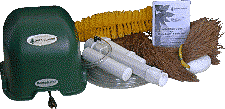The fact of the matter is that the septic tank and other components of the septic system are very durable. There is a high probability that they can be considered as close to permanent as reasonably possible.
For example, concrete, plastic or fiberglass septic tanks are very durable and rarely fail. A typical septic tank failure is most likely caused by a manufacturing defect. Concrete septic tanks can fail because of the anaerobic process by-products. The anaerobic process emits hydrogen sulfide gas. When this gas mixes with low levels of oxygen from the air it forms hydrochloric acid. This acid forms at the water lines and causes the concrete to spall or flake off the surface. This continues until a hole it eaten through the tank wall. The deterioration of concrete septic tank is much more common and severe when the potable water going into the house has high iron content. Some other causes of septic tank failure are poor installation techniques or mechanical damage caused by damaging the tank when a heavy vehicle drives over the septic tank.
Other components of the septic system, such as the distribution pipes, laterals and stone and gravel, are very durable and typically do not fail. Most septic systems installed after the mid 1970’s use PVC pipe in the distribution system. The only real failure mode of this material is mechanical damage from driving heavy equipment over the pipe and crushing it. Earlier pipe material such as concrete and clay pipe is fairly durable, although it has a higher failure rate than PVC. The stone and gravel in the drainfield is permanent from all practical perspectives.
So the question becomes, if all of these components are so durable, why can’t a septic system be considered permanent? The reason why a septic system cannot be considered permanent is because of the nature of the treatment process.
Septic systems operate in an anaerobic environment. In this environment, there is no oxygen present in the system. The bacteria that survive in this environment that digest the organic material in the septic tank and drainfield are very slow acting and produce what is called biomat.
The biomat is a living organism that grows at the infiltrative surface in the drainfield of the septic system. The biomat is comprised of anaerobic bacteria and its mucous, which is a black, smelly and sticky substance that eventually grows thick enough to create a waterproof barrier between the inside of the septic system drainfield and the native soil. When this happens, water can no longer flow through it and begins to accumulate in the drainfield. Over time, the biomat will grow up the side walls of the drainfield and create what is equivalent to a vinyl swimming pool liner around the entire perimeter of the drainfield. When the biomat is fully developed, symptoms of complete septic system failure occur, such as backups, odor and sewage water pooling in the lawn.
So, as you can see, the septic tank and other septic system components do not actually break down and fail when septic system failure occurs. The reason they are unnecessarily replaced when failure occurs is that the homeowner and contractor think that system replacement is the only option available to remove the biomat. They are unaware of the aerobic restoration process.
To eliminate the continued failure of a concrete tank an Aero-Stream aerobic treatment system should be installed. The aerobic process does not create  hydrogen sulfide gas to the tank deterioration stops as soon as the tank is converted to aerobic. The aerobic remediation system can be installed in about an hour and if much less expensive than having to replace the entire tank and most likely upgrading the entire system. Get an Aero-Stream aerobic remediation system today to save your failing concrete septic tank!
hydrogen sulfide gas to the tank deterioration stops as soon as the tank is converted to aerobic. The aerobic remediation system can be installed in about an hour and if much less expensive than having to replace the entire tank and most likely upgrading the entire system. Get an Aero-Stream aerobic remediation system today to save your failing concrete septic tank!











